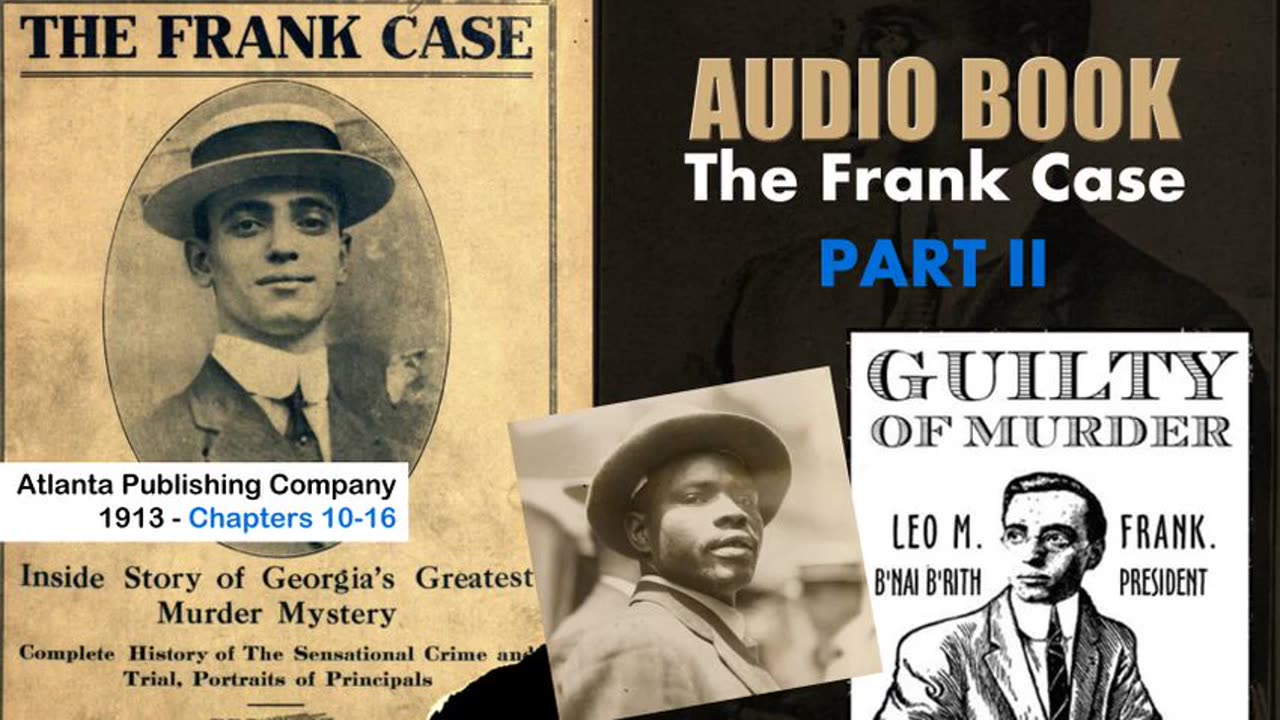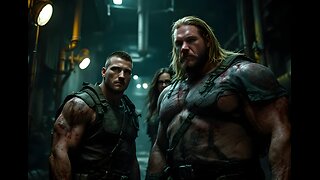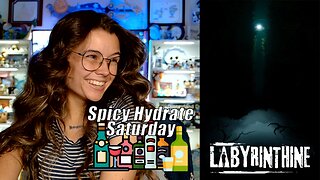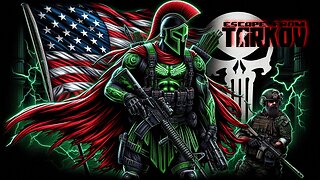Premium Only Content

The Leo Frank Case - 1913 Part 2 Chapters 10-16
James Conley, a black cleaner at the National Pencil Factory, was detained pending the coroner's inquest. At the factory, E.F. Holloway sees Conley washing shirts and calls the detective. When police arrived, Conley had partially dried his shirt, but the clothes on his back were still wet. Conley also saw Mary Phagan washing blood from a naturally dark stain on her shirt.
One day, Detective Harry Scott stopped by Jim's cell and asked him to write a few sentences. Researchers searched for handwritten references. An important detail in the document is that Jim Conley had a bad reputation and had been arrested by the police several times and was working on the street outside the factory behind the gates on Saturday when the tragedy occurred. I have. On May 23, Conley pleaded guilty to lying about being unable to write in the third degree, but swore he knew nothing about the murder. He gave police a copy of his handwriting, but police were shocked by its similarity to what was written on the girl's body. Around 10 a.m. Saturday, Conley called Detective John Black. Important details from this article: Jim Conley wrote a letter to Mr. Frank and was accused of writing it because Mr. Frank told him to. On Friday night, Mr. Frank comes to Jim and sends a letter to his mother in Brooklyn informing him that he is offering him a job. Black calls Harry Scott and he signs Black's statement. A grand jury has been convened to indict Frank Scott, and Black wants to proceed with the indictment by bringing Jim Conley before the grand jury so they can hear him. rice paddy.
However, Dorsey refused to take him to the witness stand, believing that without the black man there would be enough evidence to support Frank's accusations. Dorsey felt he could harass Frank without informing the blacks, but within hours he was proven right. Later that afternoon, Dorsey had a long meeting with the blacks and the detectives, and a brief transcript of the conversation was prepared. The detectives point out Frank's motive, but Conley continues his story. He swore several times to tell the whole truth, but investigators at the time believed he would never change his story. James Conley, sworn in his first affidavit for the state and county, said at about four minutes before one o'clock on the Friday before the holiday: At noon Mr. Frank came down the hall and asked me to come into the office his. He entered the office and asked if he could write. The factual statement refers to a black man who was given a notepad and asked to write on it. When I entered the office I asked if there were cigarettes and he brought me one. You then ask Gordon Bailey where Snowball is and he says he's in the elevator. When asked if he knew the night watchman, he said he had never seen him in the basement. Then Mr. Frank told him there were some rich people in Brooklyn, and Mr. Frank looked up and said out of the corner of his eye, "Why are you hanging?" said. All the security guard asked was not to take the money. The main takeaway from the document is that investigators are satisfied that the author of the murder letter, James Conley, has been arrested. A handwriting expert confirmed that the handwriting on the note was Newt Lee's, but even non-experts could not confirm whether it was written by Jim Conley. Detectives and forensic experts generally said the note writer put a noose around Mary Phagan's neck, but detectives were reluctant to arrest the note writer for several weeks. rice paddy. Frank's attorney said Conley went to school after the first day instead of third grade and that detectives acted as teachers, putting words in Conley's mouth. On May 27, Conley was sworn in again by Chiefs Scott and Ranford. He admitted writing the note, but said he went to the factory on Saturday afternoon and met Mr. Frank there. Conley also said that while Frank was writing notes, he nervously walked around the room and asked, "Why are you hanging them up?" he cried. Frank said he had rich relatives in Brooklyn. The detectives were satisfied until they had enough time to think about Conley's second statement. The blacks claimed that he looked them straight in the eye and told them everything they knew, even though they knew he might be a murderer. By noon the next day, Conley was holed up at the Newport-Rumford police station, but dozens of journalists gathered outside to demand that the charges be made public. The Beavers police chief was repeatedly asked to attend the meetings, but the officers refused to talk. Reporters picked up grim news from the word that leaked out the door. Chief Rumford decided to make a third black statement and the blacks waited downstairs for Mr. Frank and asked him if he wanted to make some quick money. He took the girl from there and told her that she hit her head on something. The black man screamed and said his daughter was dead and the man told him to take her to the elevator. The blacks told him to look in the cotton box and get a cloth.
As the narrator leads the woman into the dressing room, she slips and falls to the floor. Mr. Frank helps the narrator pick him up and take him to the elevator. Mr. Frank then helps the narrator back to the sawdust pile, and his hat and shoes return to the trash pile in front of the stove. The speaker then lies face down with the head facing the elevator, the left side of the face on the floor, the right side of the body up and the location of her hands at the sides. Mr. Frank says it's boring and joins the narrator in the back of the elevator. As the narrator walks Mrs. Clark from her bed to her dressing room and from the elevator to where he left her in the basement, she explains that their work was no more strenuous than Frank's. Mr. Frank took out a cigarette and asked the storyteller if he wanted a smoke. The speaker produced a box of matches and Mr. Frank handed him a pack of cigarettes. The speaker and Mr. Frank sat down on the chairs, and Mr. Frank took out a cigarette and asked the speaker if he wanted to smoke. Mr. Frank asked the speaker to write a few lines on the white board standing there. After the narrator writes, Mr. Frank looks at the newspaper and says that everything is fine. Mr. Frank asks the speaker to shut up so he can straighten things out. He then handed the speaker $200 and a large dollar bill. The speaker did not count it. James Conley was a factory worker in Fulton County, Georgia. On Friday afternoon he was at Montague Brothers, where he met Mr. I was told to meet Frank and come to the factory to continue working. He arrived around 11am. After meeting Mr. Frank, he was told to wait downstairs until he was called. He waited and fell asleep, the audio document says. According to Mr. Conley, Mr. Frank met with the Montague brothers on Friday afternoon and told them to come to the plant and work overtime. He arrived around 11am. He met Mr. Frank and was told to wait downstairs until he called him. Then he waited and fell asleep.
An African-American janitor named Jim Conley was taken to the pencil factory, where he played a prominent role in the murder. During the factory tour, detectives repeatedly questioned the person, pointing out where the body was found, where it fell and where the bag came from. He was taken to the inspector general's office, lectured with pictures about his role in the crime and his story, then went into a closet. During his visit to the headquarters, the black man said he does not accept unfair treatment. He was taken from the mill to the county jail, called the Tower, where the sheriff was in charge and the police and detectives were powerless. Black said through his lawyer that Frank's friends regularly stopped by his cell and abused him. After William Smith, the first lawyer hired by the paper to defend the Negro, won his case, the court blessed the Negro's return to police headquarters. Jim Conley, a black man, inflammatorily claimed his innocence, claimed that he was the real murderer, and tried to save his own skin by blaming the murder on the factory manager. The attorney general strongly protested how much attention was being paid to the statements of black people and asked the detectives to keep everyone out of their cells. With the exception of the city detectives, Detectives Starnes and Campbell, who were chiefs of the department at the time under the direct command of Attorney Dorsey, all were actually locked in their cells when the order was given. Jim Conley did not speak to the public before testifying at the trial and was believed to have continued to tell the story for a third time until he began adding new style in response to questions from his lawyers. In the first days after the black man made his startling remarks, hundreds of Atlantans cried out against the black man, and Frank's friends loudly criticized him. Despite the criticism, Dorsey remained calm and detectives maintained their belief that Frank was murdered. The fact that the words Frank, Conley, and Negro are all associated with the Atlanta murder mystery is one of the most important details of the phrase. After Frank was indicted for Mary Phagan's murder, the same grand jury tried to indict a black man for the same murder charge. Conley is in custody and has no chance of escaping now, as he did when he was charged with murder, said Dorsey, who has blocked efforts to indict the black man at all grand jury hearings. Dorsey continued to protest because he believed charging Conley with murder would be counterproductive and a miscarriage of justice, and multiple grand juries decided to indict the black man. If Frank remains attorney general, he promises to bring Conley to justice. The grand jury voted on whether it would be prudent to hear evidence against Conley, and Dorsey won. A second grand jury was convened before Frank's actual trial, but this time Dorsey won again.
Frank's supporters' hatred of Dorsey was fueled by an incident that occurred shortly after Frank was indicted. He accidentally discovered that the Selig family's cook, Minola Cook, and her husband, Albert McKnight, had surprising information about Frank Selig's activities at his home and statements from his supposed relatives. He told one of the bailiffs to take Minola to his office and send her to Albert. At the meeting, Detectives Starnes and Campbell asked the Attorney General if they should keep her husband in jail until they were sure he was telling the truth, but one of them lied.
On June 3, 1913, a black woman was arrested in a patrol car at Dorothy's workplace. He remained there until noon when he testified before George Gordon, a lawyer hired by an unknown party to defend him. According to the affidavit, Mr. Frank left the house at 8 a.m. on Saturday, April 26, 1913, and Albert was still there when he arrived for dinner. Mr. Frank returned home about 7 p.m. When I arrived that evening, Albert was there. Mr. Frank had dinner that evening about 7 p.m. That evening and about 8 p.m. The speaker left. They left Mr. Frank there on Sunday morning. The narrator notices that Mr. and Mrs. Selig are upstairs and that Miss Lucille, Mr. Frank's wife, is being soaked in a bucket of water by someone in a car. On Sunday morning, Albert and Miss Lucille heard that the girl and Mr. Frank had been found at work. According to Ms. Lucille, Mr. Frank said he was too drunk to let her sleep with him, so he took her gun and let her kill herself. Mrs. Frank did not know what to do because she had not visited her husband for two weeks. On Tuesday, Mr. Frank told Minola it was a shame he was in jail because of the girl. Mr. Lucille said that Mr. Frank couldn't sleep Saturday night, that he had trouble that night, and that she didn't know why he was going to kill her, so she took his gun and let him kill himself. The most important piece of information in this passage is that at the time of the murder, Minola was being paid $3.50 a week and Mrs. Shelley gave her $5 to keep quiet. Minola also said that Miss Lucille and the others warned her not to talk about what happened outside and that she preferred to spend her last night in jail rather than divulge any information. Detective Starnes also stated that neither Mr. Pickett, Mr. Craven, Mr. Campbell, nor Detective Starnes had any influence on Minola's decision to make this statement. Mrs. Lucille Selig Frank, wife of the suspect and a descendant of one of the most prominent Jews in the South, was vocal in her criticism of the investigators and the Attorney General. She argued that the Attorney General's decision to arrest and jail a cook who refused to voluntarily make false statements about her innocent husband was unreasonable and that it was not the detective's fault that he acted to protect his reputation critics. mass media. The chef has not been charged with any crime. Lucille Selig Frank admitted that there was no legal right to detain her. According to the Atlanta Journal, the woman was arrested at her Selig home shortly after Monday afternoon and cried as she was taken to the police station in a patrol car. Detectives Starnes and Campbell examined him for over an hour, after which he was subjected to third-degree torture for four hours. She was released from jail before her husband and he was also taken to the police station at noon. According to the Atlanta Journal, the woman was arrested at her Selig home shortly after Monday afternoon and cried as she was taken to the police station in a patrol car. Detectives Starnes and Campbell examined him for over an hour, after which he was subjected to third-degree torture for four hours. She was released from jail before her husband and he was also taken to the police station at noon. I listened to endless answers until I was exhausted and gave up. It is the longest statement since a woman was involved in the secret. February is invited to consider this fully.
The black woman is calm and composed while the lawyer is questioned and swears to uphold the law and extrajudicially torture the black woman. The attempt to force a witness to testify against an innocent person is the most important detail in this case. They plan to continue torturing the victim until the necessary testimony is given. I hope that no one in any civilized country will ever be convicted of murder using testimony obtained through the torture of witnesses. The plan is to continue torturing the victim until the necessary testimony is produced and use the evidence obtained through torture to produce evidence in the hope that no one in a civilized country will ever be convicted of the crime. It also states that it is planned to continue torturing the victim until the desired testimony is obtained, and that it is hoped that no person in a civilized country will be convicted of murder solely on the basis of evidence obtained by torturing a witness.
The most important information in the statement released and officially expressed is that the speaker's husband spent time with her on Saturday evening and night and was home for lunch and dinner on the day of the murder. The President knows that he has no evidence against him other than what he obtained through torture and that this will give him evidence that will be published in the press to undermine the case of anyone who tries to impeach the lawyer. The speaker also knows that rumors about their unhappy marriage have spread in society. He also knows that rumors are spreading that will defame him and the president. The narrator learns that their husband is a man with high ideals that prevent him from committing the crimes that the detectives and lawyers force him to commit. The most important piece of information in this article is that the wife of the man accused of brutally murdering a young factory worker played a key role in the investigation.
Despite the lawyer's statement that the husband did not go to the police station for two weeks after the arrest, the author knows that the husband came to the police station on the day of his arrest. Her husband was surrounded by newspaper staff and detectives, and his friends persuaded him to leave without seeing her. Meanwhile, outside, a newspaper camera crew awaited his appearance. For the first time, the wife of a man accused of brutally killing a factory girl has become the focus of the investigation.
What did Mr. Leo M Frank say to asked the Atlanta paper to respond to the plan's attorney general: The attorney general said the man's wife would be the last person to hear any evidence of his guilt and the last person to admit guilt. The attorney general also emphasized that punishing criminals always brings pain to families not involved in the crime, but courts and judicial officials cannot allow sympathy for the defenseless to lead them to aggressively pursue crimes. Accused of a murder. This is the ugly side of crime, and courts and court officials cannot allow sympathy for the defenseless to stand in the way of rigorous prosecution of the accused. Working class Atlanta and the state government praised Hugh M. Dorsey's position, and opposition to Frank grew. Frank's lawyer, Luther Z. Rosser, accused Jim Conley of murder and accused Chief A. Lanford was not sincere in his pursuit. As both sides began to prepare for Frank's trial, it became clear that this would be the greatest legal conflict in Southern history. Attorney General Dorsey announced the hiring of Frank A. Hooper to assist in the prosecution of the case. Ruben R. Arnold, perhaps the best criminal defense attorney in the South, was hired for $12,500 to assist in the defense. Rosser continued as lead counsel and was awarded $15,000 in damages.
On June 24, L.S. Roane proposed postponing the case. The trial was scheduled to begin on June 30. July 28 was decided by mutual agreement between both parties. According to the defense, Conley killed the girl on the first floor and then dumped her in a drain. On May 10, V.D. Mackworth and L.P. Whitefield searched the factory and found a paid envelope with a corner bearing the name Mary Phagan and an engraving of two figures.
They also found a bat with blood stains on it. Suspected traces of blood had previously been found near the well, and a piece of rope with a knot similar to the one around Mary Phagan's neck was also found nearby. The fines came to light following an investigation without Pinkerton Oilfield director Harry Scott. When Scott returned, he was told he had found the payment envelope, but nothing else. Chief Lanford denied that it was the factory, saying that his men had thoroughly searched the factory from top to bottom and would have found him if he had been there. The envelope was examined by a fingerprint expert, but no fingerprints were found. Bats were also found near where Conley tried to ambush him. Chief Lanford said he had no idea it was discovered, but it was also dismissed as a plant. He was harshly criticized by A. Lanford. Mr. B. Pierce, head of the Pinkerton Agency, did not notify city officials of the alleged discovery. Pierce was ostracized by the Pinkertons and left town before the trial. V before the court hearing. There was also important news. Conley W.H. Mincey said he killed the girl that morning. Mincey told the defense attorney in a statement. Mincey said he was near Conley's home at the corner of Electric Avenue and Carter Street when he approached the black party to get an insurance policy. Black warns that he is in trouble and advises him to follow him. Pierce was ostracized by the Pinkertons and left town before the trial. V before the court hearing. There was also important news. Conley W.H. Mincey said he killed the girl that morning, Mincey testified to the defense. Mincey said he was near Conley's home at the corner of Electric Avenue and Carter Street when he approached the black party to get an insurance policy. Black warns that he is in trouble and advises him to follow him. According to Mincey, when Conley asked him what his problem was, he replied that he killed the girl. Just moments before the trial began, key details of Conley's statement were made public, even though Mincey was a teacher at Rising Fawn School in North Georgia. Conley made one of his sensational claims when Mincey called police headquarters and asked to speak under the pretext of identifying an intoxicated black man, Chief Lanford recalled. The superintendent at the time said he made no recommendation for a confession and that after reviewing it, he could not confirm Conley's identity. Mincey was subpoenaed and transported to Atlanta, but the defense did not ask him to testify.
Apparently Dorsey had 25 witnesses trying to impeach him and he was impeached. Mincey had written several books on mind reading, and the lawyer had copies of those books to use during the investigation. Jim Conley never admitted that he wrote all the notes, but just one of them is an example of the general value of expert testimony. As a result, counsel obtained an expert review of both records. Six experts were willing to testify under oath that Frank, not Conley, was the author of both notes. When Dorsey finally took them to New York, Jim Conley, one of the foremost experts there, confirmed both men as authors.
When the lawyer returned, he forced the black man to admit that he had written both notes. At 8am on Monday 28 July, an hour before court opened, crowds began to gather outside the court as dawn broke in anticipation of a massive court battle. .
The crowd streamed through the entrance to the Red Building and up the short stairs to the courthouse doors, filling the corner of Hunter and Prior streets with people. Inside, dozens of fans and multiple ozone generators are installed to keep the air clean and the environment as cool as possible. Only the narrator's lawyer, journalists, close friends of the prisoners and some spectators were allowed to enter. More than 100 witnesses called to testify were assigned to a second-floor courtroom and waited their turn. Just before 7:10 p.m., the Fulton County Jail removed Frank from his cell, where he was greeted by his mother, Mrs. Mies. Ray Frank and his wife. He said he expected to be found not guilty and was relieved his long prison sentence was finally over. Before 9 o'clock he was taken to court and taken to the judge's bench.
For example, Herbert Haas, Ruben R. Arnold and attorney Luther Z. Rosser arrived, and Frank Rostrum, his wife, mother, and themselves sat on either side of him. Assistant Attorney General Hugh M. Dorsey and his Special Assistant Frank A. Hooper and the final attorney were U.S. Attorney A.E. It was Stevens. After Mr. Arnold said he was ready to proceed with the trial, Mr. Dorsey's lawyers were prepared to strongly oppose the adjournment motion. The famous trial began with L.S. Roan sitting on the couch. Several teams entered the jury room to apologize, and the clerk began calling Veniremen by name, stated Attorney Dorsey. After this formality, Roan names the witnesses. J.W. Coleman and wife Fanny Coleman plays an important role in the investigation as she is Mary Phagan's mother and J.W. is the murdered girl's stepfather.
V. H. Mincey was one of the additional witnesses requested by Dorsey's attorneys. There were 25 other witnesses, including city detectives George W. Epps, J.M. Starnes. L. S. Dobbs. W.W. Rogers, John Black, the detective, Miss Grace Hicks and L.M. Gant, Pinkerton detectives Harry Scott and B.B. Haslett, E.F. Holloway, M. B. Willem A. Gilling, Claude Smith, City Bacteriologist Dr. J.W. He was hurt, and so was his coronary doctor. doctor. Claude Smith. Dr. H. F. Harris, President Van de State Board of Health. he. pear. Miss Monteen Stover, Mr. Arthur White, Miss Helen Ferguson, Minola McKnight, E.S. Smith, Albert McKnight, and L. Stanford. Given that Detective Haslett was scheduled to appear later, and that Albert McKnight was Selig's black husband and Frank's resident cook, Minola McKnight, the three people on the list did not respond. Jim Conley, who is African-American, was issued a summons to appear in court on Tuesday. Stanford and the third witness.
The defense then called 12 witnesses, all of whom responded positively. The defense then calls the witnesses: Annie Hickson, Mrs. Levy, Mrs. . Josephine Selig, Emil Selig, H.J. Henze, R.H. Haas, W.H. Mincey, J.T. Naija, E.F. Căpitani, May Barrett is E.L. Sentell, C.N. Carson, Rebecca Carson, Harry Denham Mirza, Harry Gottheimer Mirza, Corinthia Miss Hall, Miss Hattie Hall, Mary Burke, Remy Quinn, Herbert J. Schiff, Ella Thomas, KB Gilbert, Frank Payne, Eula Flors, Alonzo Mann, Joseph Steger, Ike Straus 및 J.C. Loeb, L.J. Cohen, Emma Bibb, Bessie White, Joe Williams, Wade Campbell, William McKinley, . 리옹, 독일 Bessie White and Dora Lavender Lyons, Jerome Michael M.O. Nix and M.V. Mrs. Meyer. The twelve jurors chosen to decide Frank's fate - Meyer, Rabbi Marks, M. Jochenning and V. Woodward, J.T. Osborne, AH Henslee, FVL Smith, JT Higdon, Data Townsend, W. S. Metcalf, F.E. Winburn, Winburn AI Wizby, Chaz J. Bossard, A.I. Wisby, Chaz J. Bossard and W.M. Geoffrey. The first group was disqualified due to cause or required testing. The second and third panels were both made up of four judges, and the judges were successful.
At 11:40 the two sides met with the first selected colleague, A.H. I passed Hensley. Eleven jurors were selected from several pools of interviewees who were questioned in turn until 11:50 a.m. The final eight members each expressed their biases and prejudices or said they had prejudices. Finally, the 144th Storyteller CJ Bossard was recruited.
Twelve men selected by Judge Roane ordered a three-hour adjournment. In the waiting room behind the courtroom, Frank had the first of several dinners. At lunch, he said with a cheerful expression that the difficult process of selecting judges was over. At 3 o'clock J.W. Coleman, the mother of the dead girl, was called to testify. He spoke in a low voice, barely audible outside the jury room, wearing heavy black clothing.
Ms Coleman remembers the last time he saw his young daughter, Mary. On the morning of Saturday, April 26, Mary helped Coleman with the housework, and after helping him make a meal of cabbage and cookies, the two left the house at 11:50 a.m. and went to the pencil factory to put pens. Obtain. $1.20 for two days work. The testimony about what the girl later ate was of no importance at the time. The fact that the state used the girl's stomach to prove that she was killed is one of the most important facts of this case. The second witness the state used to support its testimony was George Epps, a childhood friend of the murder victim and one of the last people to see him alive.
He remembered taking the little boy to the corner of Forsyth and Marietta streets and dropping him off five minutes before entering the pencil factory. Old man Newt Lee watched the boy in the stands for two hours Monday afternoon and endured his grilling by Luther Z Rosser without embarrassment or irritation. Three hours later, he left the witness stand without denying what he had said. On the afternoon of the murder, he talked about finding the body, calling the police, meeting Frank, and shaking hands in the pencil factory. He was asked to repeat his story again and again, but thanks to the intelligent cross-examination of his defense lawyer, he was able to escape all the pitfalls. "He's a very scary man," he said of Luther Rosser.
Tuesday's suspension gave the state a basis to file a lawsuit against the young plant manager. They determined that he left the house at 11:50 a.m. and called a witness who reported arriving at Forsyth and Marietta streets at 12:07 a.m. or a little earlier. In the fourth trial, he called a number of police officers who had been dispatched to the pencil factory in response to Newt Lee's initial report, witnessed the body, and informed them of the body's location and appearance. And the environment. Anyone Leo M. Frank was surprised by her quiet confidence. He sat between his wife and his mother, almost neutral and emotionless, arms folded and eyes fixed on the jury, the witness stand and one of the lawyers. He seemed confident and relaxed about both his business and himself. As he sat a few feet away from the judge's bench to the left of the lawyers, friends and family gathered behind him, he was no more worried than the onlookers. The most important information in this passage is that Frank was the most obedient prisoner there and that he was never handcuffed as he moved from prison to court and from court to prison. He was also given special freedom to move around the court and never ignored his guardian's instructions. Besides eating all his meals (except dinner) in the answering room in the morning and afternoon, he constantly entertained six to ten friends.
Her employers, other men she worked with at the factory, and numerous subordinates believed she was innocent. The immoral charges brought against him at his trial did not shake that belief. One of the suspect's friends referred to a woman at the trial who he said was a bigot and of no good character, and called a witness who accused Frank of having an inappropriate relationship with a factory worker's wife a false witness . Colleague of Mary Phagan, R.P. Barrett, a mechanic in the metal room, reported seeing blood stains near the water cooler and several strands of hair wrapped around a shelf handle a few feet away.
He said a broom was also found nearby, believed to have been used to spread liquid on the floor and cover the blood. According to the theory behind the murder, Frank took his victim to the medal room when he entered the office to collect his pay, then killed him when the victim refused to submit to the abuse. Two of the most important pieces of information in this text are from L.S. Dobb's testimony, as well as that of Christopher Columbus Barrett, who was a member of the group, brought the dead girl aside the morning her body was discovered.
The morning the body was discovered, one of the group led L.S. Dobbs to the dead girl. The defense argued that the apparent marks did not originate in the elevator, but at the bottom of the stairs leading from a first-floor pit several meters away. City police investigator J.N. Starnes, the official prosecutor in the case, testified about several important details related to the city police investigation.
The facts of the case are the most important information in this audiobook. The morning after Frank's body was discovered, De Slate walked into the office of the pencil factory and told CEO Darley, "See, I've got another suit." According to Starnes' testimony, Frank was nervous and anxious Sunday morning. There was controversy early in the case and the jury was dismissed. The controversy arose on Tuesday afternoon, July 29, when attorney Dorsey Conley tried to enter into evidence a drawing of a pencil factory with red lines showing the path the body took when it was moved from the room metal in the basement.
"Boots" Rogers testified that on the morning of April 27, when Frank and Detective John Black got into the car to take the inspector to the crime scene, Frank was very worried. The state tried to prove that Frank did not see the dead girl's face while she was at the company's hair salon. According to Rogers, the inspector left the room where the body was stored and entered another room after arriving at the company's beauty salon. Frank later contradicted other witnesses, claiming he saw the girl's face not once, but twice. Rogers' sister-in-law, Miss Grace Hicks, said the girls in the metal room often brushed their hair over the equipment and that there was a gas jet right next to the shelf where Barrett found the hair. It was Maria Phagan's. After spending several hours on the witness stand, City Detective John Black was subjected to some of Rosser's most brutal cross-examination of the entire case. In addition, Detective Starnes' testimony was sustained in connection with the subsequent police investigation. Pinkerton's agency gave defense attorneys access to the information, but Dorsey's attorneys pointed out that the discovery of bloody wounds and footprints on the floor near a sewer pipe leading to the basement was never reported to police. Attorney Rosser questioned the detective about the bloody shirt found in Newt Lee's home. He recognized the black shirt as the one found at the bottom of the black barrel.
The defense's attempt to introduce evidence about the T-shirts was met with strong legal opposition. Mr. Dorsey said that on the Sunday after the murder, Frank went to the night watchman's house and hid the shirt there. Frank also said the dress was a plant. On the morning of July 31, Detective Harry Scott of the Pinkerton Agency said a man who visited the factory months after the murders and who later helped gather evidence against him described his experience at the factory. kill him Through this witness testimony, the lawyer tried to prove that Frank tried to cross-examine Gantt. The important point about this passage is that the witness Frank Gantt did not say that he knew the girl who was killed while working at the factory, and Dorsey claims that the witness misunderstood him here. Attorney Rosser argued that because the suspect resisted his attempts to make sense of the matter, the prosecutor should have told the court that the witness had been charged before the cross-examination began. When asked by Detective Scott Dorsey if he believed the attorney withheld information, Dorsey denied the allegation that he withheld information. A state government spokeswoman confirmed that was not the case, but said investigators had overlooked the information. He then asked Scott about the advice he received about hiding evidence after Scott left his job. Frank's lawyers go to Haas and have a conference call to discuss Pinkerton's role in the investigation. After some discussion, Mr. Haas said he wanted us to get a police report. A startling revelation emerged Thursday afternoon. Mel Stanford, a young factory worker, said he swept the floor of the metal room the Friday before the murders but found no traces of Haskelline or blood. Luther Z. Rosser could not give up his cause. Read the metal floor in the room. City bacteriologist Doctor Claude Smith said he found the organism in one of them. Gilling Jane Palmer William and T.P. J. Bloomfield. Bloomfield said she had been dead for 12 to 15 hours when she discovered Mary Phagan's body hidden in the basement of the pencil factory. Factory guard E.F. Holloway is accused of masterminding the murder, saying he left the elevator's motor control box unlocked on the day of the murder. Dorsey's evidence showed that after he asked Frank Conley to help him dispose of the body, he went to the office and took the keys to the dumpster before starting the car. Holloway said she locked the elevator when she got home, but then thought twice and forgot to lock the shelves. Mrs. Arthur White's testimony on Friday, August 1, covered most of the important details of the text. She went to the factory to meet her husband at 11:30 a.m., had a brief conversation and then left, the affidavit said. He returned 30 minutes later and went to Frank's workplace. She then went to the fourth floor, where her husband and Harry Denham were working, and remained there until 12.50, when Frank arrived and told her he would close the building until noon. According to the wife When Frank reached the fourth floor, he acted naturally. White. He also explained that as he was leaving the building, he saw a black man hiding in the dim light at the first floor entrance. According to him, the state offense occurred between the first and second visit. When he was called to the witness stand, M.V. Darley admits that Frank was worried on the morning of April 27th. According to him, the factory manager called him out of bed in the morning and told him that he had come to the factory before preparing an ordinary cup of coffee. One of the surprising things about this story is that State Health Commissioner H.F. Harris. The body was exhumed and an autopsy performed 9 days after the initial burial. According to him, the girl died 50-75 minutes after lunch. doctor. His story was later confirmed by a local doctor. Other medical experts deny this. When I got my Ph.D., Harris tried to determine the time of death through an inquest, but the defense wanted to show that he was only guessing. According to other witnesses, this was not just a guess, but a scientific judgment. doctor. Harris said the victim's eye was blackened by the blow before his death and the head injury that left him unconscious was caused by a sharp object. doctor. He confirmed the doctor's testimony. He described the injuries sustained by Harris and the girl. Selig House chef Alfred McKnight said he was in the kitchen on Saturday, April 26, when Frank walked into the restaurant and took a moment to look in the mirror. Saturday, W.F. Anderson Detective Stenographer G. February. Police Chief Beavers, Detective Wagoner and Officer Lasseter were also contacted. The first week of the trial was dominated by testimony from the factory manager and police chief Helen Ferguson. A newspaper was found on Judge Roane's desk with a red headline reading "Add a link to the chain", which the lawyers objected to. After a five-minute interview, the attorneys returned to the courtroom and asked the jury to dismiss. Attorney Dorsey warned the jury not to be influenced by what they have seen recently or will see in the future. Several additional witnesses were interviewed in the first week, but their testimony revealed nothing that the police and private investigators conducting the investigation had not already uncovered. On Monday, August 4, the second week of the trial began, the state introduced James Conley, a black man who worked as a factory manager and could directly link Frank to the murders. Conley was the state's key witness. When news broke that a black man would be questioned that day, more people than anyone else surrounded the courthouse. The crowd was anxiously waiting for a black man to take his place. By 8.30am, police had approached hundreds of people and plans were made to force spectators to queue until the doors opened.
All the women who attended the meeting had to leave before the hearing began. L.S. Roan said from the couch. James Conley, who was charged with disorderly conduct in the police court, was a witness. He told Glibly how he had taken the dead girl's body to the cellar on the orders of Chief Inspector Frank. A witness sensationally claimed that Frank was seen kissing a woman in the factory office, and on other Saturdays and public holidays, he was seen holding secret meetings with women at the building's second-floor entrance. The witness testified that Frank was told to return to the factory on Friday afternoon and Saturday morning. When I first met the witness, I told him that it was still a little early to do what I wanted to do and asked him to follow me like every Saturday. He saw them upstairs talking to the young women, then he looked towards the door and promised to let them know when he saw them. Mr. Frank was alone on Thanksgiving, and witnesses said he was followed as he is on other Saturdays. On the morning of April 26, 1912, Conley and Dorsey went to the Capitol Laundry and met Mr. Frank at Nelson and Forsyth Streets. This is the most important detail in this text. Conley asked Dorsey if he could go to the Capital Laundry after leaving the factory and meet Mr. Frank at Nelson and Forsyth streets. Mr. Dorsey asked him to go to the Capital Laundry, and when he returned to the factory he met Mr. Dorsey at Nelson and Forsyth streets. I asked him if I could meet Frank. Dorsey asked him to go to the Capital Laundry, and when he returned to the factory he met Mr. Dorsey at Nelson and Forsyth streets. I asked him if I could meet Frank. Back at the factory, Dorsey asked him if he could go to the Capital Laundry and meet Mr. Frank at Nelson and Forsyth streets. The most important piece of information in this text is that Conley saw Lemmie Quinn, Mary Phagan, and Monteen Stover enter the building in that order, but Mary never left. Back at the factory, Dorsey asked him if he could go to the factory. The most important piece of information in this text is that Conley saw Lemmie Quinn, Mary Phagan, and Monteen Stover enter the building. The next person to come down was Miss Monteen Stover, dressed in a red coat and tennis shoes. He woke up when he heard Mr. Frank turn his head and the door slam shut in Mr. Frank's direction. As I went upstairs as instructed, I heard Mr. Frank whistling. Mr. Frank acted strangely on the stairs, shaking and wringing his hands when he whistled. The black man stood up, spread his legs, held his hands, and moved his right hand back and forth behind his head, then in the opposite direction. Attorney Dorsey said the belt was removed from Mary Phagan's neck. In her testimony, Mary Phagan, a black woman, objected to Frank's promotion, saying he was back in the medal hall. Frank said the girl fell and was injured after the fight. Conley claimed that Frank told him that he was different from other men, citing an earlier incident in which the black man interrupted the young captain while Frank was having a strange relationship with another girl.
The most surprising thing about this trial was the questioning of Conley. His direct examination lasted less than two hours. For three and a half days, Luther Z. Rosser peppered the black witness with questions to persuade him of certain aspects of his testimony, but the black witness never lost his cool. As the questioning turned into a fitness test, Attorney Arnold entered the room to cross-examine the witness. It took four stenographers working 30-minute shifts to record Conley's testimony, and as soon as one finished recording, he rushed to his typewriter and typed notes.
Two hours after Conley's formal statement was filed, a copy of it was delivered to attorneys. Attorney Rosser saw Frank having fun with his friends in the office and asked the black man about the incident. A black man said he first saw this performance in July 1912. Daisy Hopkins, née Dalton, and the woman who works on the 4th floor. When they came in, she was cleaning and Mr. Frank called her into his office and asked if she wanted to make some money. After asking the question, Mr. Frank told him to look at the door. He sat and watched the young lady go back and forth with Mr. Dalton. Ms Mr. Dalton left after 10 or 15 minutes. When they descended the stairs and entered the cellar, the negro led them back and opened the hatch. The witness did not know how long the couple had been in the basement, but said he found the couple waiting by the hatch and opened the door when they did not answer questions. While the girl waited at the top of the stairs, Dalton said he went outside and into the office. Received $90 from Mr. Dalton and Mr. Frank. The girls left around 4:30 p.m. When you leave. The suspect asked the witness to explain what happened when the woman visited the factory two weeks later on Saturday. Conley said he wanted Frank to come in early in the morning and let him drive in the afternoon. Frank returned to the office around 2:15 p.m. That afternoon, Mr. Holloway entered the office and left shortly afterwards. A moment later the black man announced the arrival of Miss Daisy Hopkins. Then he followed her up the stairs and into the office. The most important piece of information in this case is that Jim Conley, a black man who had been stalking Frank for two years, waited at the door for a woman to come in and snap her fingers to bring Frank down. When asked if it was Thanksgiving, Rosser, who is black, said it was early winter before Thanksgiving. The black asked Mr. Roger when he last worked as Frank's bodyguard and he said it was in the early winter before Thanksgiving. The black asked Mr. Rosser when he last worked as Frank's watchman, in the early winter before Thanksgiving. The next time the negro served as Frank's companion, when Mr. Rosser asked him about it, he replied that it was Thanksgiving dinner in the early winter. He asked if the last time Mr. Rosser served as Frank's bodyguard was at Thanksgiving dinner in the early winter. Conley was questioned by investigators about his statements to police and admitted to lying to police. They said they arrived at the factory around 8 or 8:30 a.m., about 30 minutes later. He said he last saw him in Mr. Frank's office about three days ago and hadn't seen him since. He said he had a beautiful face, was dressed in black and was upstairs making boxes. When Mr. Frank entered the door, he locked it and closed it behind him. An hour and a half later he came out. As they headed for the door, the woman asked, "Did you see her?" he asked. "And Mr. Frank said, 'Yes, that's the best nigger.' "I've seen him before," he said. Conley was questioned by detectives about all the statements he made in his police statement and eventually admitted he lied.
Summary of this article: By the end of the first day of questioning, prosecutors were so happy that Conley was telling the truth that they took the surprising step of removing all of Conley's testimony from the trial. It is removed orally. Check out how Frank and his comments attacked the recent actions of black people. Attorney Arnold argued that the testimony was irrelevant, irrelevant, incompetent and inadmissible.
He also decided to attack Frank's character and exclude some black testimony from the defense's cross-examination. Hooper's attorney said that if there were no objections from the court when the evidence was presented, it would be free and fast to allow Conley to call witnesses.
Meanwhile, the defense team wanted to withdraw the wiretapping testimony in another case, but Judge Roan stopped it, saying that if the objection had been raised at the time the testimony was given, it would have been properly admitted. Frank's mother tapped him on the shoulder and whispered in his ear, wrapping her arms around his neck as he bowed his head.
In court, Dorsey's attorney said the evidence was favorable. "This should not be accepted," Mr. Rosser said. Attorney Dorsey replied that it would not be proper to cross-examine this witness for two days before appearing before him, and then asked that part of it be withdrawn. This makes corroborating testimony about Frank's actions impossible.
Other witnesses are awaiting Jim Conley's confirmation, the attorney said. Conley asked the court to allow him to call witnesses to prove he was telling the truth. The lawyers asked the court for fairness and justice after they investigated the operations of the National Pencil Factory and discovered Conley's connections to six other people. The prosecution also referred to Mr. Arnold's statements and evidence. Wounds were added to the evidence of Mary Phagan's murder. The lawyers asked the court for fairness and justice after investigating the activities of the National Pencil Factory and showing Conley's connections to six others. Mr. Dorsey asked the defense to release all decisions that violated that rule in the past five years. During Frank's trial, the suspect's wife, Frank, stood up and walked down the aisle. When he entered the garden, tears flowed from his eyes. Mr Arnold called the evidence in the dispute "vicious and rotten" and said the accused had suffered needlessly. The only excuse is that the country did not object in time and they want to keep it that way. A man is tried only once in a criminal case. Attorney Arnold said introducing false and unnecessary evidence in a murder case is like accusing a suspect of the same crime. In his defense, he said the state asked the man to testify and used a lot of strange evidence to support his sordid story. Arnold also criticized the Supreme Court ruling cited by Dorsey's lawyers for applying to cases involving the legal sale of cocaine, not murder. He said that if the evidence is accepted, the murder investigation should be dismissed in favor of the other two cases because murder is a very different and serious matter than cocaine trafficking. The most important thing in this text is that Judge Roan ruled on April 26 that all possibilities except surveillance cannot be taken for granted. Hooper's attorneys asked the judge to delay the decision until Wednesday to give the state time to investigate the case and make a decision. Attorney Rosser continued to cross-examine Conley even after the jury was called back into the courtroom. Judge Roane said he could change his mind if he was wrong. After the jury returned to the courtroom, Attorney Rosser continued to cross-examine Conley.
-
 3:57:19
3:57:19
EvilT4000
7 hours ago $1.58 earnedSaturday.....🟢For energy and focus click my Dubby link!
24.8K3 -
 3:02:55
3:02:55
SlingerGames
4 hours agoSpartan Night - Halo and More | Creator for @SELFMADEGGS
16.4K -
 3:57:49
3:57:49
Mally_Mouse
10 hours agoSpicy Saturday!! - 10k CELEBRATION! - Let's Play: Labyrinthine
32K1 -
 37:09
37:09
The Mel K Show
10 hours agoMel K & Dr. Kirk Moore | A Doctor’s Oath: Doing What is Right No Matter the Cost | 7-26-25
32.4K15 -
 LIVE
LIVE
Cewpins
5 hours agoCuphead while BLAZED🔥420💨710🍃!MJ
46 watching -
 11:09:40
11:09:40
MDGgamin
13 hours ago🔴LIVE - TARKOV & ARMA - Shots For Subs Saturday!!! - Chilling & Chatting - #RumbleTakeover
4.63K -
 LIVE
LIVE
Eternal_Spartan
5 hours agoCollab w/ TheBeardedNerdd! | TARKOV AND MORE | Join the Best Chat on Rumble!!!!
35 watching -
 36:44
36:44
NordicVentures
6 days ago $2.84 earnedWINTER Bushcraft 2 Nights: Building ALONE a Survival Shelter
14.8K4 -
 5:11:38
5:11:38
JakRazGaming
8 hours ago $1.03 earnedPlaying Minecraft with GameQuest1552, Rexmon, and JuicyKinnKandy! Stream 9
10.9K -
 LIVE
LIVE
GoA_Malgus
6 hours agoGoA Malgus - The Legend Has Returned!!! - Live domination on Black Ops 6
14 watching